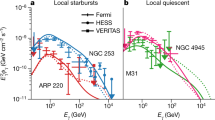Abstract
SURVEYS of cosmic radio emission carried out at metre and decametre wavelengths with telescopes of low resolving power detect the galactic background, a small number of intense discrete sources, and an isotropic background contributed by the integrated emission from extragalactic sources which are too faint to be detected individually. The brightness of this extragalactic background has recently been estimated from a spectral analysis1 of the total radio background at metre and decametre wavelengths, and from an analysis2 of the distribution of the total background at 85 MHz. The results of these studies imply that the brightness temperature of the extragalactic background is in the range 250° to 400° K at 85 MHz. It is likely that the extragalactic sources which contribute to this background have a distribution of spectral indices similar to that found in samples of the more intense extragalactic sources3. In this case, the brightness of their integrated emission would increase with decreasing frequency more rapidly than the brightness of the galactic background; the extragalactic component would contribute a greater proportion of the total brightness of any given area of sky as the observing frequency is decreased.
This is a preview of subscription content, access via your institution
Access options
Subscribe to this journal
Receive 51 print issues and online access
$199.00 per year
only $3.90 per issue
Buy this article
- Purchase on Springer Link
- Instant access to full article PDF
Prices may be subject to local taxes which are calculated during checkout
Similar content being viewed by others
References
Bridle, A. H., Mon. Not. Roy. Astro. Soc., 136, 219 (1967).
Yates, K. W., Austral. J. Phys., 21, 167 (1968).
Williams, P. J. S., and Bridle, A. H., Observatory, 87, 280 (1967).
Reber, G., J. Franklin Inst., 285, 1 (1968).
Mathewson, D. S., and Healey, J. R., Intern. Astro. Union URSI Symp. No. 20, 283 (1964).
Broten, N. W., Mount Stromlo Symp. Magellanic Clouds, 72 (1965).
Bridle, A. H., Mon. Not. Roy. Astro. Soc., 138, 251 (1968).
Scheuer, P. A. G., Nature, 207, 1024 (1965).
Field, G. B., and Henry, R. C., Astrophys. J., 140, 1002 (1964).
Gould, R. J., Amer. J. Phys., 35, 376 (1967).
Longair, M. S., Mon. Not. Roy. Astro. Soc., 133, 421 (1966).
Author information
Authors and Affiliations
Rights and permissions
About this article
Cite this article
BRIDLE, A. Extragalactic Radio Background at 2.1 MHz. Nature 219, 1136–1137 (1968). https://doi.org/10.1038/2191136a0
Received:
Issue Date:
DOI: https://doi.org/10.1038/2191136a0
Comments
By submitting a comment you agree to abide by our Terms and Community Guidelines. If you find something abusive or that does not comply with our terms or guidelines please flag it as inappropriate.



